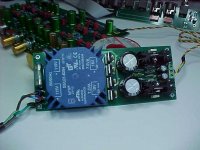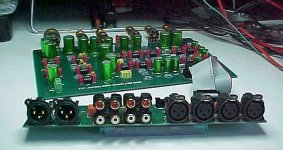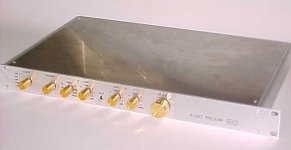Unbalaced inputs.
Yes, I get your point. I don't have a single balanced source (I do have a balanced power amp). Maybe this build is not for me. Perhaps the DS Precision Preamplifer is what I'm after. Wow that's an expensive PCB though...
M.F.Walker
> if I only wanted unbalanced inputs can I .....
?? That's like modifying TV's Batmobile into a Ford Galaxie. Take off a lot of fancy-stuff. Doug Self shows unbalanced inputs earlier in the book. While the book is copyrighted, this circuit and values are not critical or original. At "C", if input levels are huge, make R2 a pot; if signals are happy size but there is a need to fade to silence, make R4 a pot.
Yes, I get your point. I don't have a single balanced source (I do have a balanced power amp). Maybe this build is not for me. Perhaps the DS Precision Preamplifer is what I'm after. Wow that's an expensive PCB though...
M.F.Walker
C: As a general rule, attenuation should only take place on the volume control.
B: First attenuataion then amplification. Bad thing! Isn't it?
.........if input levels are huge, make R2 a pot.....
Take it in context.
Just completed this preamp working on getting panels cut Rather than reinvent Foes anyone have available .DXF files that can be used for front and back panels? I have tried to convert the .pdf files I have found on the site bug won’t convert. Any help appreciated
Thanks
Thanks
Thanks. I'll check the thread. Parts came from Mouser.
In my last batch ordered from Mouser I had a 200K/3W resistor 1% Metal Oxide which I paid for 7,34 Euros ant it turned out to measure 32K. So it is not a matter of the supplier.
Question for Doug Self...
Is that possible to change the value of the input capacitors (C2 & C4) for less than 47uF. I would like to try polypropylene audio capacitors and 47uf is difficult to find or very expensive.
Is that possible to change the value of the input capacitors (C2 & C4) for less than 47uF. I would like to try polypropylene audio capacitors and 47uf is difficult to find or very expensive.
In response to the question: "should it be a simple $3 chip driving a graphic module or do we go all out and use a BBB?" I would favor a two step approach. First the $3, and then a BBB design. Integrating microprocessor circuits into a preamp will certainly present challenges, but they are all solvable with proper design work, and the majority of this work is hardware design work, not software work. The BBB (or similar) with a graphics display will mostly be software work, and just how much time does one want to spen on the dark side?
Is it possible to use a wall wart power supply at either 15 volts DC or 18 volts I see them out there that claim linear for 15 bucks and up
Reducing the size of the capacitors increases the risk of distortion and a drop in the low frequencies region. But you only know exactly when you do a measurement with a good audio analyzer.Question for Doug Self...
Is that possible to change the value of the input capacitors (C2 & C4) for less than 47uF. I would like to try polypropylene audio capacitors and 47uf is difficult to find or very expensive.
Question for Doug Self...
Is that possible to change the value of the input capacitors (C2 & C4) for less than 47uF. I would like to try polypropylene audio capacitors and 47uf is difficult to find or very expensive.
You can put these
Solen Fast, 47uF, 630V :: Solen Fast :: Film Foil :: Capacitors :: Passive Components :: Electronic Parts :: Banzai Music GmbH
A 630V cap for audio coupling, of line level signals, there must be something more economical
The whole point made by Douglas, for using these high-capacity electrolytics, is that the signal across them is so low that any distortion is too low to be measured or heard.
If you now go to lower capacity values in order to be able to use boutique parts is a bit ironic.
Jan
If you now go to lower capacity values in order to be able to use boutique parts is a bit ironic.
Jan
use boutique parts is a bit ironic.
Lots of people want to be a millionaire.
A 630V cap for audio coupling, of line level signals, there must be something more economical
Then maybe these are more suitable.
https://gr.mouser.com/ProductDetail/WIMA/MKP4D054707J00JSSD?qs=dTJS0cRn7ohm7eCcyQKW1A==
No, I guess you do not understand what Jan has said to you.
If anything put a 1- 2u2 film cap across the ecap as specified by Doug, honestly you will never hear or measure any difference so you are wasting your $
If anything put a 1- 2u2 film cap across the ecap as specified by Doug, honestly you will never hear or measure any difference so you are wasting your $
You could use two in seriesIs it possible to use a wall wart power supply at either 15 volts DC or 18 volts I see them out there that claim linear for 15 bucks and up
Take a look : Nichicon Muse ES bipolar caps measured: <-120dB THD, <-140dB IMD
Any polypropylene 47uf/630v (or lower voltage ) cap will be at least as big as an 15000uf/63v electrolytic capacitor.
For this preamp , replacing the 47uf nichicon es coupling caps with pp 47uf caps is absurd.
The es caps are excellent caps, the price for the 47uf pp cap wil be at least 20 times more and the size of the pp caps is at least 10 times more .
Any polypropylene 47uf/630v (or lower voltage ) cap will be at least as big as an 15000uf/63v electrolytic capacitor.
For this preamp , replacing the 47uf nichicon es coupling caps with pp 47uf caps is absurd.
The es caps are excellent caps, the price for the 47uf pp cap wil be at least 20 times more and the size of the pp caps is at least 10 times more .
I have had quite a few inquiries for PCB kits of late. A few months ago I had let my supply lapse. Interest had fallen off and the cost to mail them overseas had skyrocketed. Cost to ship overseas reach $35 US.
My question is, "Is there enough interest to make another run?" It's a great project that cannot be beat for value or sound quality.
So, please let me know if there is a real interest.
My question is, "Is there enough interest to make another run?" It's a great project that cannot be beat for value or sound quality.
So, please let me know if there is a real interest.
Attachments
- Home
- Source & Line
- Analog Line Level
- Doug Self Preamp from Linear Audio #5



